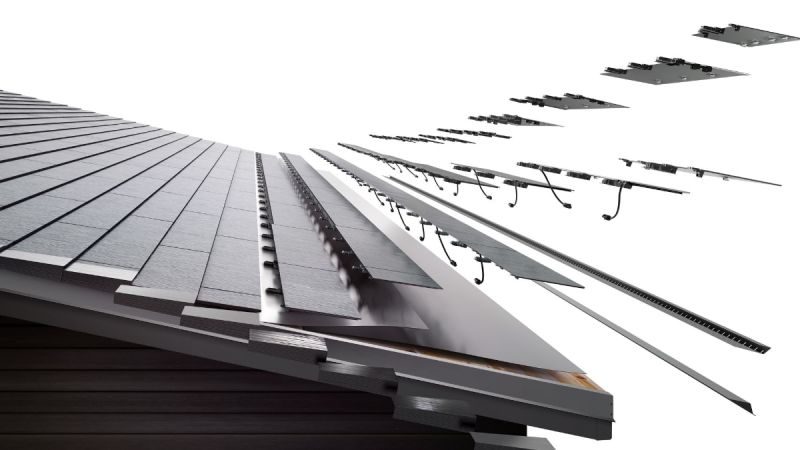The Swiss manufacturer has developed photovoltaic tiles available in the usual formats and in different colors. With a special coating, even the glare effect of solar modules can be eliminated. However, small-format solar cells are less productive and more expensive than classic roof systems.
According to the manufacturer, it is compatible with a large number of common tile formats. This means that one or more "Match" solar modules can replace existing roof tiles without the need for adjustments to the roof structure. The whole range of colors in which the "Match" can be ordered is also new. In addition to the typical shades of the tiles, customers can also choose between classic solar glass or other glass surfaces. Even tile-like roof and wall coverings, such as fiber cement panels, can be substituted for photovoltaic tiles.

The whole solar PV system is also easy to install on existing roofs: the manufacturer promises customers a simple and easy installation. The system consists solely of the glass solar module and a mounting hook. Existing roof slats can still be used, but an additional slat is required for the mounting hook. Each «Match» tile has a connection for the positive and negative pole, as well as long cables that can go vertically or horizontally.
They claim that the special "ZeroReflect" surface coating reduces the perception of glare to almost zero. Interestingly, the anti-glare coating is not only available for Megasol products, it can also be applied to existing photovoltaic systems from other manufacturers. However, there is a caveat: the solar tiles also have lower performance and higher cost than traditional solar panels. Unfortunately, due to these disadvantages, photovoltaic tiles are still more of a niche product. The main reason is the low performance of solar tiles per area, combined with higher costs compared to conventional roof systems. The colored versions of the solar tiles have even greater performance losses than the transparent models with glass surfaces.
The manufacturer Megasol maintains that the photovoltaic tiles would replace a normal roof. According to the company, if a roof is completely covered again with "Match" tiles or other solar tiles, the costs are comparable to those of a tiled roof with a solar system on it. With a life expectancy of 50 years, the Swiss manufacturer even assumes cost savings during operating time. After all, Megasol grants a guarantee of up to 35 years for its photovoltaic tiles. In addition, they are very resistant: can achieve class 4 protection against hail.

As for the Tesla Solar Roof, we can quickly review some of its key features: a 24/7 monitoring system which allows you to control your panels at any time and from anywhere in the world through a mobile application; the application tracks the performance, efficiency and generation of the panels, in addition to detecting any problems in the system in real time. Another important detail has to do with the looks: Tesla prioritizes the design of its roof panels in a way that the competition does not, creating a sleek, blended, low-profile installation that provides direct curb appeal.
Tesla solar roof and panels basically pay for themselves: Tesla states that this system produces 25-32 kWh per day, which, at the current rate, is $3.21-$4.10 per day. If the rate stays constant, the system will pay for itself in roughly 8 -12 years, but it depends on many different parameters, like location, utility prices, etc. (pricing is different on a state-by-state basis).
There are some other things to take into account, like customization (as part of the Tesla solar panel installation process, homeowners submit photos of their equipment and available spaces rather than having a team inspect these areas). This way, the total costs can be lowered significantly. Also, the exact nature of the installation chosen for each home will be customized based on roof type, energy needs, geography, budget and much more.

After Tesla installs your solar system, you will still be connected to the grid and have an account with your electric utility provider. Your rate plan may change post-installation as required by your utility provider. Solar can greatly reduce your electric bill, but you will often still have a residual bill. However, with all these considerations in mind, Tesla tries to ensure that it can offer a lower cost through its price-match guarantee. The way this program works: owners can submit a recent quote (within 14 days of ordering) from a competitor for a similar solar system, and Tesla will match the price.
But as a whole, a wise combination of Solar PV + Storage, be it Megasolar or Tesla Solar Roof (and Powerwall batteries), makes good sense from a financial & economic point of view (that will certainly pay off in the mid – long run), but more importantly, in terms of a sustainable and green-oriented ecological investment.
All images courtesy of Tesla Inc.
Nico Caballero is the VP of Finance of Cogency Power, specializing in solar energy. He also holds a Diploma in Electric Cars from Delft University of Technology in the Netherlands, and enjoys doing research about Tesla and EV batteries. He can be reached at @NicoTorqueNews on Twitter. Nico covers Tesla and electric vehicle latest happenings at Torque News.











